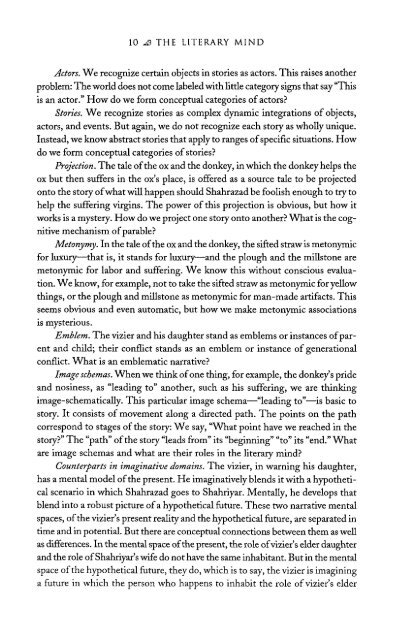The Literary Mind.pdf
The Literary Mind.pdf
The Literary Mind.pdf
Create successful ePaper yourself
Turn your PDF publications into a flip-book with our unique Google optimized e-Paper software.
10 THE LITERARY MIND<br />
Actors. We recognize certain objects in stories as actors. This raises another<br />
problem: <strong>The</strong> world does not come labeled with little category signs that say "This<br />
is an actor." How do we form conceptual categories of actors?<br />
Stories. We recognize stories as complex dynamic integrations of objects,<br />
actors, and events. But again, we do not recognize each story as wholly unique.<br />
Instead, we know abstract stories that apply to ranges of specific situations. How<br />
do we form conceptual categories of stories?<br />
Projection. <strong>The</strong> tale of the ox and the donkey, in which the donkey helps the<br />
ox but then suffers in the ox's place, is offered as a source tale to be projected<br />
onto the story of what will happen should Shahrazad be foolish enough to try to<br />
help the suffering virgins. <strong>The</strong> power of this projection is obvious, but how it<br />
works is a mystery. How do we project one story onto another? What is the cognitive<br />
mechanism of parable?<br />
Metonymy. In the tale of the ox and the donkey, the sifted straw is metonymic<br />
for luxury—that is, it stands for luxury—and the plough and the millstone are<br />
metonymic for labor and suffering. We know this without conscious evaluation.<br />
We know, for example, not to take the sifted straw as metonymic for yellow<br />
things, or the plough and millstone as metonymic for man-made artifacts. This<br />
seems obvious and even automatic, but how we make metonymic associations<br />
is mysterious.<br />
Emblem. <strong>The</strong> vizier and his daughter stand as emblems or instances of parent<br />
and child; their conflict stands as an emblem or instance of generational<br />
conflict. What is an emblematic narrative?<br />
Image schemas. When we think of one thing, for example, the donkey's pride<br />
and nosiness, as "leading to" another, such as his suffering, we are thinking<br />
image-schematically. This particular image schema—"leading to"—is basic to<br />
story. It consists of movement along a directed path. <strong>The</strong> points on the path<br />
correspond to stages of the story: We say, "What point have we reached in the<br />
story?" <strong>The</strong> "path" of the story "leads from" its "beginning" "to" its "end." What<br />
are image schemas and what are their roles in the literary mind?<br />
Counterparts in imaginative domains. <strong>The</strong> vizier, in warning his daughter,<br />
has a mental model of the present. He imaginatively blends it with a hypothetical<br />
scenario in which Shahrazad goes to Shahriyar. Mentally, he develops that<br />
blend into a robust picture of a hypothetical future. <strong>The</strong>se two narrative mental<br />
spaces, of the vizier's present reality and the hypothetical future, are separated in<br />
time and in potential. But there are conceptual connections between them as well<br />
as differences. In the mental space of the present, the role of vizier's elder daughter<br />
and the role of Shahriyar's wife do not have the same inhabitant. But in the mental<br />
space of the hypothetical future, they do, which is to say, the vizier is imagining<br />
a future in which the person who happens to inhabit the role of vizier's elder















